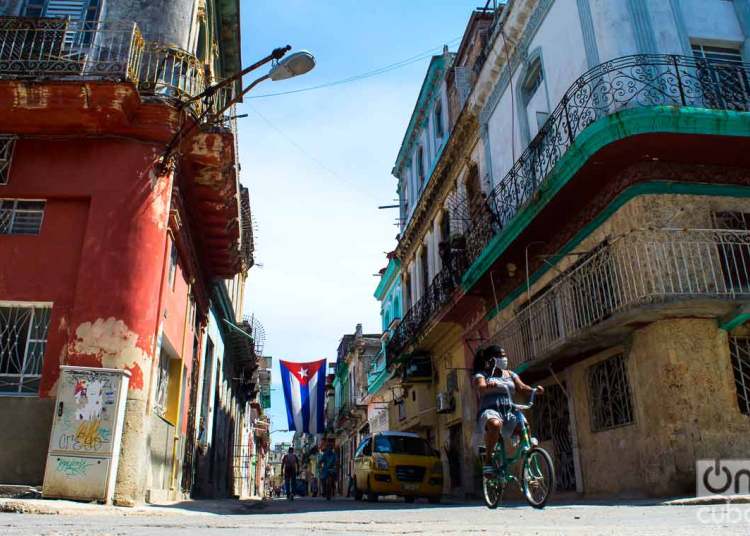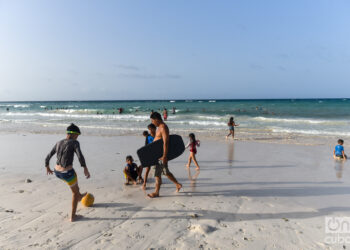The COVID-19 pandemic has plunged the world into mounting tragedy and shock. The loss of life, fear, the anxiety of the sick and confined; and then, the impact on the economy, have been the ingredients. The drop in production and employment; the decrease in supply (sometimes of essential goods); the rapid transmission of shock to demand; the rupture of global production chains, among other elements, reveal themselves as obvious and unexpected channels for the extension of a crisis that is affecting everyone.
Cuba will definitely feel the immediate and combined impact of the disease and the negative economic shock. There will be a decrease in the availability of foreign currency―disappearance of the tourist market, difficulties in credit for defaults to countries and commercial creditors, probable decrease in remittances, decrease in exports of some items―and the impossibility of sustaining the usual invoice for imported goods (for consumption with emphasis on food and other vital goods for production processes).
A growing paralysis of economic activity, a progressive deterioration of the income of the population and the treasury, increases in informality and job insecurity in the initial stages of recovery, and inflationary pressures around essential goods such as food, personal hygiene and cleaning products, among others, are to be expected.
The situation has been aggravated by the presence of the U.S. blockade, which the current administration has marked with its peculiar sign by adding higher levels of aggressiveness in an attempt to cut Cuba’s channels of access to foreign currency―travel, remittances, campaigns against the export of medical services―and access to fuels.
In any case, the presence of the blockade has always placed Cuban policy makers in a sub-optimal situation: hardly any decision in the commercial, credit, investment, etc. fields can be the best. However, the distortions of our economic model in the fields of ownership and management, the lack of incentives for the production of wealth, the design of policies and market structures; condition that the Cuban economy reach levels of efficiency and production below its potentials.
In what areas can the Cuban authorities take action to mitigate the impacts of the crisis and overcome them? It is basically about obtaining income, growing quantitatively and qualitatively, and consolidating a project that goes beyond mere survival.
Changes in economic model’s components
Probably the most daring measures to take are at the level of the economic model or in the short-term structural ones that end up modifying the character of some of its components. This constitutes a field to level, since the current content and interrelation of these components is not conducive to the growth dynamics necessary for the country.
In this sense, an expansion of the domestic private sector―which since the 2010 opening confirmed its growth capacity based on engines other than privatization, growing from about 147,000 self-employed workers to more than 620,000 in a pre-COVID-19 stage―and the management “experiments” of state assets, promoting dynamics of public-private integration, could channel maximization profit actions in the achievement of national objectives.
As a rule, it will be necessary for both the state and private spheres to break the monopoly and oligopoly arrangements and make way for the increasing incorporation of suppliers and competition dynamics.
Expansion of domestic private sector
The replacement of the positive list that today authorizes some 130 activities in the Cuban private sector with a negative one, would be in line with the gradual continuity of the reforms begun in 2010. At that time, the authorization of a limited group of activities (and in general, qualitatively naive) and the possibility of hiring a workforce, generated, however, a notable growth in the domestic private space.
The aforementioned occurred in a context of absence of credit incentives (initially, and later limited), disproportionate fiscal demands, absence of a regulatory framework for the creation of joint ventures with foreign or Cuban public capital, disconnection of formal channels of foreign trade and lack of access to wholesale markets. The entrepreneurial spirit took advantage of assets, savings, inventiveness, and even managed to seduce informal foreign capital flows that have been estimated at 50% of the amount of remittances arriving in the country.
What the private sector will need is a smart regulation that encourages competition, eliminates the discriminatory treatment it suffers with respect to the state sector and foreign investors, channels its actions to generate foreign exchange (through investments and trade) and articulates it together with the state sector in meeting demand and projects of national interest.
So far, while no radical changes are in sight, there are encouraging elements. In the current period of containment of the pandemic, state and private activities have been restricted according to criteria of health preservation and not of ownership. The private sector has obtained facilities to act on their own initiatives to obtain temporary suspensions in its operations that alleviate the fiscal burden in contexts of decrease or paralysis of activity.
Agricultural production
In the food sector, where the non-state sector has stood out for being the most productive in most areas, these urgencies are expressed vehemently. Inputs and liquidity should be redirected towards those that have demonstrated responsiveness in terms of production.
It is necessary to guarantee levels of products that reach the population through regulated mechanisms, while the rest transits through efficient channels (of any ownership or management) of collection and distribution that guarantee their arrival to the consumer at prices that stimulate the different parties involved in the value chain. The Cuban State must necessarily continue to expend large resources to immediately guarantee Cubans’ food needs through imports, but the recovery of agriculture depends on breaking with any practice that has hampered its performance.
Foreign currency availability
The time has come for the Cuban authorities to generate extraordinary incentives for the arrival of Foreign Direct Investment (FDI) and to direct it towards well-identified priorities. It will be necessary for the officials in charge of the negotiation processes to receive material incentives linked to success in attracting flows.
Intermediary agencies for the hiring of local workers must disappear or adjust their leonine demands, which in practice make the workforce more expensive (investors pay the agency, and also the workers, to keep them efficient). The local private sector should be authorized to develop initiatives with foreign capital, on a small or other scale, where their contribution is not necessarily measured in capital, but in innovation and knowledge of the Cuban context.
The determination of incentives for the use of remittances in productive efforts, rather than in consumption, and greater efforts to the bartering of the debt (which must be honored) in investment participation, are also other options on the table for the authorities.
Ensuring the growth of an efficient production plant, with the capacity to meet domestic demand and to export, must be a priority.
In the face of all the obvious adversities, the availability of skilled labor, the advantages for investors who first reach a budding market, and the geographical location of Cuba and the Mariel Special Development Zone, stand as fortresses in conditions of resizing of global production chains.
Increase in income from export of goods and health-related services
In the current context, exports of medical services in different modalities, and that of medical equipment and biotechnological and pharmaceutical products, are emerging as expanding options. Today they are notable sources of export earnings. According to official figures, the export of health-related services contributed almost USD 6.4 billion in 2018, while biotech and pharmaceutical products could be over USD 400 million.
Emergency medical brigades have been deployed to some 20 nations, reinforcing the already existing presence in 60 countries. Some receive the services in solidarity variants, but a set of them―including some that are recently added, such as Andorra―will probably constitute new sources of income for Cuba. This will have a remarkable demonstrative effect and constitutes a diversification of markets, adding countries with high per capita incomes.
In the case of goods, Cuba also reports having received increasing requests for biotech products, including nationally produced interferons, which have given promising results when being included in the experimental treatments for COVID-19 patients.
In addition to the above, an expansion of medical tourism can be added in the future. Although this will depend on a bold strategy by Cuba to empower the island as a destination as soon as international travel begins to recover; the advantages in terms of price, unique treatments and image, are a reality that currently exists.
Moderately repowering the tourism sector
Since before the pandemic spread, a group of academics has questioned the growing investment effort in the tourism sector. This is based on the urgent need to recover other sectors (such as industry and agriculture); deterioration due to lack of maintenance of part of the plant in operation; the contraction of the U.S. market, the initial determinant of the recent tourist commitment and the comfortable levels of occupation reached in recent years. In 2019, the tourism sector’s 74,211 rooms averaged an annual occupancy of 48.2%, one of the lowest in the history of modern tourism in Cuba.
For the Cuban authorities, dialogue with the counterparts of ongoing investments, depending on their level of execution, will be an imminent task. But from now on, the discontinuation of the investment effort in new hotels must become a firm decision.
Cuban authorities should consider the domestic private sector as an ally more than ever, make available to it the marketing channels fundamentally reserved for the state sector or its joint ventures with foreign companies, and jointly participate in the generation of income. The expansion of the activities available for private practice is essential. Otherwise, informality will predominate, raising risks and decreasing income for all parties.
By way of closing
We must mention other topics, including the financial and monetary. Apparently, for the moment, the much-discussed monetary unification has moved to another level of analysis by the authorities. Everything indicates that although the CUC will tend to disappear in the medium term, the existence of new stores in freely convertible currency is showing that, regardless of whether it is recognized, we are in the presence of partial dollarization, although cash is not used in the final transaction.
A necessary issue before moving on to the new Law on Enterprises of 2022, is to clarify the role that Cuban small and medium-sized private companies should play in the future project. How to avoid the state undercapitalization of the Cuban light industry, a national imperative, to avoid unnecessary imports?
Would it be out of these analyzes to know whether or not it is convenient to have a state monopoly on foreign trade, in the old national way? Should monopolies exist in some economic activities, in the absence of healthy competition with benefits for all?
Once the epidemic is left behind, or the worst of it, Cubans will have survived. Hopefully regretting the least amount of loss of life possible. The living and the healthy will then have to face the urgency to survive.
Confusing the strengths of centralization and crisis management in the short term with the validation of a continued attachment to practices that drag secular debts with growth and development, will condemn us to a scenario of increased precariousness and will continue mortgaging our future as a nation.
It may be different. Surviving will be an arduous exercise, but healthier if that exceptional effort is made in a context where the options tend to grow and not to be limited. It will be a welcome change, a continuation of the logic of the 2010 reform, bearer of a vision of the future in the individual if it is properly combined in the collective.
—
A more extensive version of this text can be found in Horizonte Cubano:










